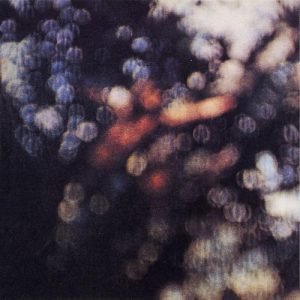Released in June 1972, “Obscured by Clouds” stands as a fascinating waypoint in Pink Floyd’s illustrious discography, bridging the gap between the band’s earlier experimental phase and the monumental success of “The Dark Side of the Moon.” As the soundtrack for Barbet Schroeder’s film “La Vallée,” this album finds Pink Floyd exploring a more straightforward, song-oriented approach compared to their sprawling psychedelic epics of the late 1960s. Nestled between “Meddle” (1971) and the aforementioned “The Dark Side of the Moon” (1973), “Obscured by Clouds” provides a snapshot of a band in transition, testing new waters while refining their sonic identity.
In the broader music landscape, 1972 was a year of evolution and experimentation. The progressive rock scene was flourishing, with bands like Yes, Genesis, and Emerson, Lake & Palmer pushing the boundaries of rock music. Amidst this backdrop, Pink Floyd’s “Obscured by Clouds” offers a more accessible, yet still richly textured, collection of tracks that would help cement their reputation as innovators in the genre.
Artistic Intentions
The album was conceived with a dual purpose: to serve as a film score and as a standalone studio album. This duality is reflected in its structure and execution. Roger Waters, David Gilmour, Richard Wright, and Nick Mason aimed to create music that not only complemented the visual narrative of “La Vallée” but also stood on its own as a cohesive work. In interviews and album notes, the band has spoken about their desire to balance cinematic atmospheres with more conventional rock songcraft. This effort resulted in an album that, while less grandiose than their later works, showcases their ability to blend mood-setting instrumentals with evocative lyrics and melodies.
“Obscured by Clouds” can be seen as an artistic exercise in restraint and focus, providing a more intimate glimpse into Pink Floyd’s creative process. It captures the essence of a band on the brink of legendary status, experimenting with their sound in a way that would soon lead to some of the most iconic albums in rock history.
Sonic Exploration

Production Quality
“Obscured by Clouds” showcases a production quality that reflects the technological limitations and creative decisions of its time. Recorded at Château d’Hérouville in France, the album’s production is relatively straightforward, opting for a warm, analog sound that captures the raw energy of the band’s performances. The clarity of the recording allows each instrument to shine, yet there is a certain atmospheric haze that permeates the album, lending it a dreamy, almost otherworldly quality. This production style complements the themes of exploration and introspection, fitting seamlessly with the film’s visual narrative.
The album’s mix is balanced, with a clear delineation between instruments, ensuring that the intricate details of Pink Floyd’s arrangements are not lost. The production, while not as polished as later efforts like “The Dark Side of the Moon,” serves the music well, creating an immersive listening experience that draws the audience into the band’s evolving sonic landscape.
Musical Arrangements
Pink Floyd’s “Obscured by Clouds” is a masterclass in musical arrangements, with each track offering a unique blend of instruments and textures. The band employs a variety of instruments, including synthesizers, slide guitars, and traditional rock setups, to create a rich tapestry of sound. Notable arrangements include the title track, “Obscured by Clouds,” which opens the album with a pulsating, synth-driven ambiance that sets the tone for the rest of the record.
Vocals are used sparingly but effectively, often layered with harmonies that enhance the ethereal quality of the music. David Gilmour’s guitar work is particularly memorable, ranging from the soulful solos in “Burning Bridges” to the more aggressive riffs in “Childhood’s End.” Richard Wright’s keyboard contributions add depth and dimension, while Roger Waters’ bass lines provide a steady, grounding presence.
One of the standout arrangements is “Wot’s… Uh the Deal,” a song that combines acoustic guitar with lush keyboard lines and harmonized vocals, creating a poignant and reflective mood. The instrumental track “Mudmen” showcases the band’s ability to build dynamic, evolving soundscapes, with Gilmour and Wright’s interplay creating a sense of movement and space.
Genre Elements
“Obscured by Clouds” touches upon several musical genres and subgenres, blending them in a way that is distinctly Pink Floyd. The album primarily sits within the progressive rock genre, characterized by its experimental approach and complex compositions. However, it also incorporates elements of psychedelic rock, particularly in the more atmospheric and instrumental tracks.
Tracks like “The Gold It’s in the…” and “Childhood’s End” lean towards classic rock, with their straightforward structures and energetic performances. Meanwhile, songs such as “Mudmen” and “Absolutely Curtains” delve into ambient and electronic territory, showcasing the band’s willingness to push genre boundaries and explore new sonic landscapes.
Lyrical Analysis

Themes and Messages
“Obscured by Clouds” weaves a rich tapestry of themes, reflecting both the narrative needs of the film “La Vallée” and the band’s own introspective tendencies. Central to the album is the theme of exploration, both physical and metaphysical. This is evident in tracks like “Burning Bridges” and “Wot’s… Uh the Deal,” where the lyrics speak to journeys, relationships, and the passage of time. The recurring motif of nature, which mirrors the film’s setting in the remote, uncharted regions of Papua New Guinea, is a significant presence in the lyrics, evoking a sense of awe and respect for the natural world.
Another prominent theme is the search for meaning and understanding. Songs like “Free Four” and “Stay” delve into the human experience, touching on life’s fleeting nature, the inevitability of death, and the desire for connection and purpose. These themes are expressed through a blend of personal reflection and broader existential musings, allowing listeners to find their own interpretations within the lyrics.
Lyrical Depth
The lyrics of “Obscured by Clouds” strike a balance between straightforward narrative and abstract poetry. Roger Waters, who penned the majority of the album’s lyrics, employs a direct yet evocative style that captures the essence of the themes without becoming overly cryptic. For example, in “Free Four,” Waters reflects on the inevitability of death with a candidness that is both poignant and matter-of-fact: “Life is a short, warm moment / And death is a long cold rest.”
In contrast, tracks like “Childhood’s End” are more metaphorical, inviting listeners to delve deeper into the imagery and symbolism. The song’s lyrics explore the transition from youth to adulthood, using the metaphor of a journey to convey the passage of time and the search for identity: “You shone like the sun / But now there’s a million years to wait for the dawn.”
The album’s lyrical depth is further enhanced by the interplay between the personal and the universal. While the lyrics often draw from personal experiences and emotions, they are crafted in a way that resonates with broader human experiences, making them both intimate and relatable.
Emotional Impact
The emotional resonance of “Obscured by Clouds” is profound, with the lyrics playing a crucial role in evoking a range of emotions. The introspective nature of songs like “Stay” and “Wot’s… Uh the Deal” elicits a sense of melancholy and contemplation, as the band reflects on themes of love, loss, and the passage of time. The simplicity and honesty of these lyrics allow listeners to connect deeply with the music, finding their own emotions mirrored in the band’s words.
Conversely, tracks like “Free Four” and “Childhood’s End” evoke a sense of urgency and existential reflection. The candid discussions of life’s brevity and the inevitability of death prompt listeners to reflect on their own lives and the fleeting nature of existence. This blend of personal and philosophical reflection gives the album a rich emotional texture, encouraging empathy and introspection.
Cohesion and Flow

Track Progression
“Obscured by Clouds” demonstrates a well-considered track progression that enhances its overall listening experience. The album opens with the instrumental title track, “Obscured by Clouds,” which sets a meditative tone with its atmospheric synths and rhythmic drive. This smoothly transitions into “When You’re In,” another instrumental piece that builds on the established mood with a more robust rock sound, seamlessly bridging the gap between the ambient opener and the more structured songs that follow.
As the album progresses, the tracks flow into one another with a natural ease, creating an immersive journey. For example, the transition from the reflective “Burning Bridges” to the upbeat “The Gold It’s in the…” offers a dynamic shift that keeps the listener engaged while maintaining a cohesive sonic palette. The album’s midpoint, marked by tracks like “Wot’s… Uh the Deal” and “Mudmen,” balances introspective balladry with expansive instrumental passages, ensuring a varied yet coherent progression.
The closing tracks, including “Childhood’s End” and “Absolutely Curtains,” bring the album to a contemplative and somewhat somber conclusion. “Childhood’s End” serves as a poignant penultimate track with its lyrical exploration of growing up, while “Absolutely Curtains” wraps up the album with an ethereal instrumental that echoes the opening themes, providing a sense of closure and completeness.
Thematic Consistency
Throughout “Obscured by Clouds,” Pink Floyd maintains a remarkable thematic consistency, ensuring that the album feels like a unified work rather than a collection of disparate songs. The recurring themes of exploration, nature, and existential reflection are woven seamlessly through both the lyrics and the musical compositions, creating a cohesive narrative thread.
Musically, the album stays true to a style that balances progressive rock elements with more accessible, song-oriented structures. This consistency is evident in the use of recurring musical motifs, such as David Gilmour’s expressive guitar solos and Richard Wright’s atmospheric keyboards, which tie the tracks together stylistically. Even the instrumental tracks, which could potentially disrupt the flow, are carefully placed to enhance the overall narrative and emotional journey.
The emotional tone of the album is also consistent, shifting naturally from contemplative and introspective to more energetic and assertive, without any jarring transitions. This balance allows the album to explore a range of emotions while maintaining a coherent mood that reflects the film’s narrative and the band’s artistic intentions.
Standout Tracks and Moments
Highlight Key Tracks
Several tracks on “Obscured by Clouds” stand out for their artistic merit, innovation, and emotional impact:
“Wot’s… Uh the Deal”: This track is a standout due to its melodic beauty and lyrical depth. The song combines acoustic guitar with lush keyboard lines, creating a poignant and reflective mood. The lyrics explore themes of life’s fleeting nature and the search for meaning, making it one of the album’s most introspective and emotionally resonant tracks.
“Childhood’s End”: This song marks a pivotal moment in the album, both thematically and musically. Its lyrics reflect on the transition from youth to adulthood, using metaphors of light and darkness to convey the journey. Musically, it features a driving rhythm and soaring guitar work from David Gilmour, showcasing the band’s ability to blend thought-provoking lyrics with powerful rock instrumentation.
“Mudmen”: An instrumental track that stands out for its rich, dynamic soundscape. The interplay between Gilmour’s guitar and Wright’s keyboards creates a sense of movement and space, making it a highlight of the album’s instrumental prowess. The track’s evocative textures and evolving structure exemplify Pink Floyd’s talent for creating immersive musical experiences.
“Free Four”: This track is notable for its upbeat, almost pop-like melody juxtaposed with dark, introspective lyrics. Roger Waters delivers a candid reflection on life and death, making it one of the album’s most lyrically striking songs. The contrast between the catchy tune and the heavy subject matter makes “Free Four” a memorable and impactful listen.
Memorable Moments
The Opening of “Obscured by Clouds”: The album’s opening track sets the stage with its haunting, synth-driven ambiance. The gradual build-up and layering of sounds create an immersive introduction that draws listeners into the album’s sonic world. This moment captures the essence of Pink Floyd’s ability to create atmospheric and evocative music.
Guitar Solo in “Wot’s… Uh the Deal”: David Gilmour’s guitar solo in this track is a masterclass in melodic expression. The solo’s emotive phrasing and nuanced dynamics elevate the song, providing a moment of pure musical beauty that encapsulates the album’s reflective tone.
Lyrical Moment in “Free Four”: The line “Life is a short, warm moment / And death is a long cold rest” from “Free Four” is one of the album’s most striking lyrical moments. Roger Waters’ direct and unflinching meditation on mortality resonates deeply, leaving a lasting impression on the listener.
Instrumental Break in “Mudmen”: The instrumental break in “Mudmen,” where the music shifts from serene to intense, showcases Pink Floyd’s talent for dynamic composition. The interplay between guitar and keyboards during this section is particularly memorable, highlighting the band’s chemistry and musical intuition.
Closing of “Absolutely Curtains”: The album closes with “Absolutely Curtains,” an instrumental track that ends with a field recording of New Guinea natives singing. This unconventional ending reinforces the album’s themes of exploration and cultural intersection, providing a unique and thought-provoking conclusion.
Artistic Contribution and Innovation

Place in Genre/Industry
“Obscured by Clouds” occupies a unique place in both the progressive rock genre and the broader music industry of the early 1970s. Released in 1972, it served as a precursor to Pink Floyd’s groundbreaking album “The Dark Side of the Moon” and is often viewed as a transitional record that bridges their early, more experimental work with their later, more polished productions. In the context of the music industry, “Obscured by Clouds” exemplifies the era’s spirit of exploration and genre fusion, contributing to the progressive rock movement’s expansion beyond conventional rock boundaries.
The album’s creation as a soundtrack for Barbet Schroeder’s film “La Vallée” also highlights Pink Floyd’s versatility and willingness to integrate their music into multimedia projects. This approach was relatively uncommon at the time and demonstrated the band’s innovative thinking, positioning them as pioneers in blending rock music with cinematic elements. By doing so, Pink Floyd not only expanded their own artistic horizons but also influenced the way music could interact with other art forms, encouraging future collaborations across different media.
Innovation
Several aspects of “Obscured by Clouds” stand out as particularly innovative and fresh, reflecting Pink Floyd’s continual push to evolve their sound and artistic approach:
Integration of Soundtrack Elements
The album’s dual role as a film soundtrack and standalone studio album showcases the band’s ability to craft music that is both thematically rich and adaptable to different contexts. This integration of cinematic elements into their music was innovative, demonstrating how rock music could enhance and be enhanced by visual storytelling.
Experimental Use of Synthesizers
“Obscured by Clouds” features extensive use of synthesizers, particularly in the opening and closing tracks. The synthesizer work adds a layer of atmospheric depth that was ahead of its time, prefiguring the more elaborate electronic explorations that would become central to their later works. This experimentation with electronic sounds contributed to the evolving landscape of progressive rock and electronic music.
Diverse Musical Styles
The album’s blend of progressive rock, ambient soundscapes, and more conventional rock elements highlights Pink Floyd’s innovative approach to genre fusion. Tracks like “The Gold It’s in the…” with its straightforward rock energy, contrast with the ambient instrumental “Mudmen,” showcasing the band’s ability to traverse and merge different musical styles seamlessly. This eclecticism was a significant departure from the more uniform sound of many contemporary rock albums, pushing the boundaries of what a rock album could be.
Thematic Exploration
Lyrically, “Obscured by Clouds” delves into themes of exploration, existential reflection, and the human condition. This thematic depth, combined with the album’s musical diversity, created a complex and multi-layered listening experience. The band’s willingness to tackle profound and often abstract concepts in their lyrics was innovative, encouraging listeners to engage with their music on a deeper intellectual and emotional level.
Field Recording Integration
The closing track, “Absolutely Curtains,” ends with a field recording of New Guinea natives singing. This incorporation of non-Western musical elements was innovative for its time, reflecting a growing awareness and appreciation of global cultures in Western music. It also underscored the album’s themes of exploration and cultural intersection, adding a unique and authentic dimension to the record.
Closing Thoughts

“Obscured by Clouds” is a noteworthy entry in Pink Floyd’s discography, marking a significant period of transition and artistic exploration for the band. As a soundtrack album, it successfully merges the needs of cinematic accompaniment with the standalone demands of a rock album, showcasing the band’s versatility and creative prowess.
Strengths
Cohesive Artistic Vision: The album maintains a thematic and sonic consistency that ties its tracks together, creating a unified listening experience. The exploration of nature, the human condition, and existential themes is handled with subtlety and depth, resonating with listeners on multiple levels.
Innovative Soundscapes: Pink Floyd’s use of synthesizers, field recordings, and a blend of musical styles demonstrates their willingness to push boundaries and experiment with new sounds. This innovation adds layers of texture and complexity to the album, setting it apart from more conventional rock records of its time.
Emotional and Reflective Lyrics: The lyrical content of the album strikes a balance between straightforward narrative and poetic abstraction, inviting listeners to reflect on their own lives and experiences. Tracks like “Wot’s… Uh the Deal” and “Free Four” offer poignant insights that enhance the album’s emotional impact.
Dynamic Musical Arrangements: The band’s instrumental prowess shines throughout the album, with memorable solos, rich keyboard textures, and intricate interplay between instruments. This dynamic range keeps the album engaging from start to finish.
Weaknesses
Transitional Nature: As a transitional album, “Obscured by Clouds” sometimes lacks the cohesiveness and polish of Pink Floyd’s later masterpieces. Certain tracks may feel less fully realized compared to their more iconic works, and the album’s dual purpose as a soundtrack and studio release occasionally leads to moments that might seem less focused.
Inconsistent Impact: While many tracks stand out for their innovation and emotional depth, others may not resonate as strongly with all listeners. The album’s more subdued and introspective moments might not appeal to those seeking the grandeur of albums like “The Dark Side of the Moon.”
Place In Career
“Obscured by Clouds” is a compelling album that captures Pink Floyd in a phase of creative growth and experimentation. It offers a fascinating glimpse into their evolving sound and artistic ambitions, setting the stage for their subsequent groundbreaking work. Its blend of innovative soundscapes, thematic depth, and emotional resonance makes it a significant, if sometimes overlooked, entry in their catalog.
Official Rating
We award this album an 8/10 rating. This rating reflects the album’s strengths in innovation, cohesive thematic exploration, and emotional impact. While it may not reach the towering heights of Pink Floyd’s most celebrated albums, “Obscured by Clouds” remains a vital piece of their artistic journey, offering a unique and enriching listening experience that continues to captivate audiences. Its position as both a standalone album and a film soundtrack showcases the band’s versatility and willingness to push the boundaries of rock music, securing its place as a noteworthy and influential work in their discography.
